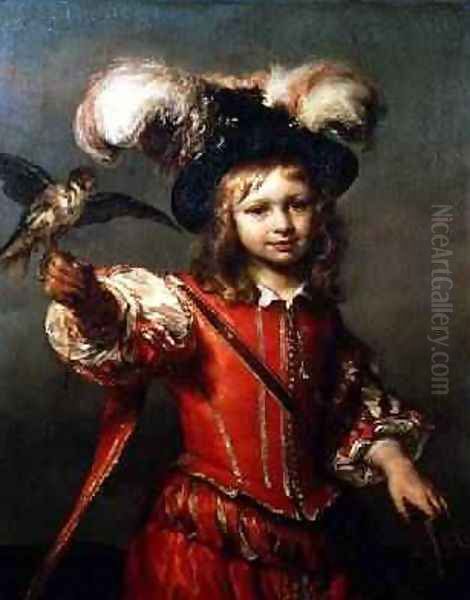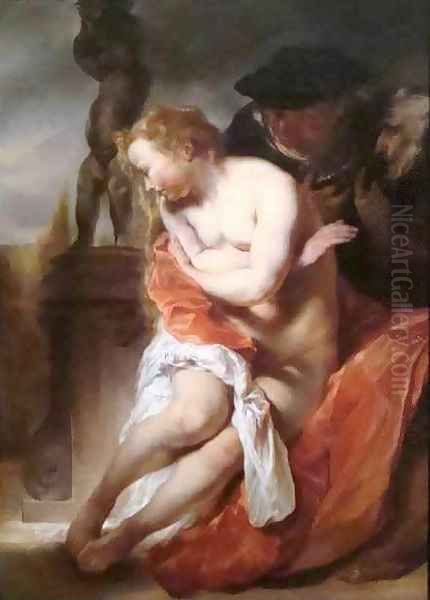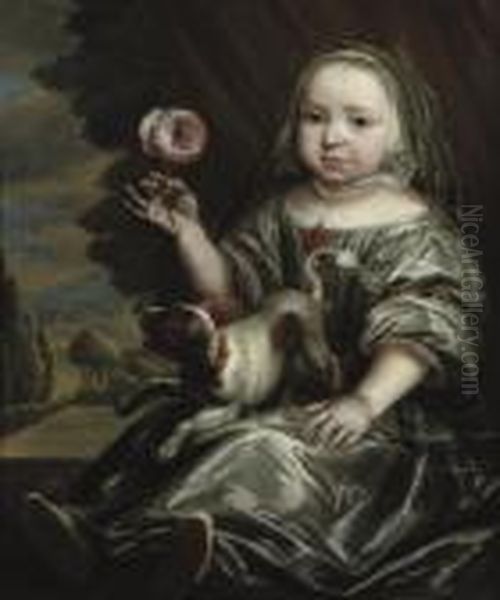The Dutch Golden Age, a period of unprecedented artistic efflorescence in the 17th century, produced a constellation of brilliant painters whose names resonate through art history. While masters like Rembrandt van Rijn, Johannes Vermeer, and Frans Hals are universally celebrated, the era also nurtured a wealth of other highly skilled artists whose contributions are equally significant, though perhaps less widely known. Among these is Jan van Noordt, a painter of remarkable expressive power and technical finesse, whose work is increasingly being recognized for its unique synthesis of prevailing artistic currents and its own distinct character. For too long, his oeuvre was partially obscured by misattributions and a lack of focused scholarly attention, but modern research is steadily bringing his achievements into clearer focus, revealing an artist of considerable stature.
The Artist's Identity and Active Period
The correct spelling of the artist's name is Jan van Noordt. He was active primarily in Amsterdam, the vibrant hub of the Dutch Republic's cultural and economic life. His lifespan is generally placed from approximately 1623 or 1624 to his death in 1676. This places him squarely within the most dynamic decades of the Dutch Golden Age, a contemporary to many of its leading figures. His body of work encompasses historical paintings, compelling portraits, and engaging genre scenes, all marked by a distinctive energy and a rich, often dramatic, use of color and light.
Formative Influences and Early Life in Amsterdam
Jan van Noordt was born in Amsterdam, a city teeming with artistic talent and opportunity. The exact details of his earliest training remain somewhat elusive, a common challenge when reconstructing the lives of many 17th-century artists. However, art historians have identified strong stylistic connections that suggest his artistic lineage. It is widely believed that he was significantly influenced, and possibly even directly taught by, Jacob Adriaensz Backer (c. 1608–1651). Backer himself was a prominent Amsterdam painter, known for his elegant portraits and ambitious history paintings, initially influenced by the Utrecht Caravaggisti and later by the burgeoning classicism, as well as the early work of Rembrandt. If Van Noordt did study with Backer, he would have been exposed to a sophisticated blend of painterly traditions.

The artistic environment of Amsterdam in the mid-17th century was incredibly rich and competitive. Rembrandt van Rijn (1606–1669) was a towering figure, whose innovative approach to composition, light, and psychological depth profoundly impacted generations of artists. Simultaneously, the influence of the Flemish Baroque, particularly the exuberant style of Peter Paul Rubens (1577–1640) and the refined elegance of Anthony van Dyck (1599–1641), was palpable, often transmitted through prints, imported artworks, and artists who had travelled south. Van Noordt’s work demonstrates a fascinating absorption and reinterpretation of these diverse influences. His family background also offers an interesting, though indirect, connection to the arts: his father was reportedly a music teacher, and his brother, Abraham Jacob van Noordt, was a noted organist and carillonneur. This immersion in a culturally rich milieu may have subtly shaped his artistic sensibilities.
The Artistic Crucible of Amsterdam
To fully appreciate Jan van Noordt's career, one must understand the unique artistic ecosystem of 17th-century Amsterdam. The city was a global trade center, its wealth fueling an unprecedented demand for art. Unlike in Catholic countries where the church and aristocracy were primary patrons, in the Protestant Dutch Republic, a burgeoning middle class—merchants, civic leaders, and affluent burghers—became avid art collectors. This led to a diversification of subject matter, with portraits, genre scenes, landscapes, and still lifes gaining immense popularity alongside traditional history paintings.
Painters like Van Noordt operated within this dynamic market. He was a contemporary of numerous other talented artists vying for commissions and sales. Besides Rembrandt and Backer, other notable figures active in Amsterdam during parts of his career included Bartholomeus van der Helst (1613–1670), a highly successful portraitist whose polished style often found more favor with civic patrons than Rembrandt's more introspective approach. Ferdinand Bol (1616–1680) and Govert Flinck (1615–1660), both former pupils of Rembrandt, developed successful careers, adapting their master's style to suit prevailing tastes. Van Noordt would have been aware of their work and the broader artistic currents they represented. He was also a founding member of Amsterdam's Brotherhood of St. Luke, an artists' organization, indicating his active participation in the city's artistic community.
Jan van Noordt's Distinctive Artistic Style
Jan van Noordt’s mature style is characterized by its vibrancy, dynamism, and emotional depth. He skillfully blended the dramatic lighting and psychological insight associated with Rembrandt and his school with the rich colors, sensuous forms, and dynamic compositions reminiscent of Flemish masters like Rubens and Van Dyck. This fusion was not merely imitative; Van Noordt forged a personal idiom that was both powerful and refined.

His brushwork could be bold and energetic, particularly in the rendering of fabrics and flesh, conveying a sense of movement and vitality. His palette was often warm and luminous, with a sophisticated understanding of color harmonies and contrasts that contributed to the emotional impact of his scenes. In his history paintings, which often depicted biblical or mythological subjects, Van Noordt demonstrated a talent for complex compositions, arranging multiple figures in dynamic and engaging ways. He paid careful attention to the play of light and shadow (chiaroscuro), using it not just to model form but also to heighten drama and focus the viewer's attention on key narrative elements. His portraits, while perhaps less numerous than his history pieces, capture the sitter's personality with a lively immediacy.
Compared to some of his contemporaries who leaned towards a more polished, classicizing finish, such as Caesar van Everdingen (c. 1616/17–1678), Van Noordt often retained a more painterly quality, where the artist's hand remained visible, imbuing his works with a sense of spontaneity. This approach aligns him more with the expressive tendencies seen in Rembrandt's circle, though his color choices and figure types often show a stronger affinity with the Flemish school.
Key Themes and Representative Works
Jan van Noordt explored a range of subjects popular in his time, demonstrating his versatility. His oeuvre includes significant contributions to history painting, portraiture, and genre scenes.
One of his most celebrated works is Susanna and the Elders (various versions exist, e.g., c. 1660s). This biblical story, a popular subject in Baroque art, allowed artists to explore themes of virtue, vulnerability, and lechery, often with a dramatic and sensuous charge. Van Noordt’s interpretations typically feature dynamic compositions, expressive figures, and rich, tactile rendering of fabrics and flesh, showcasing his ability to convey intense emotion and narrative tension. The vulnerability of Susanna is often contrasted effectively with the predatory intent of the elders.
Another iconic painting is A Boy with a Falcon and Leash (e.g., version in the Wallace Collection, London, dated c. 1665). This captivating work, sometimes considered a portrait or a genre piece with allegorical undertones, exemplifies Van Noordt's skill in capturing youthful character and his rich, warm palette. The boy's direct gaze, the luxurious rendering of his costume, and the carefully depicted falcon create a compelling image that is both intimate and subtly grand. The subject of a child with a pet or a symbol of status was common, but Van Noordt imbues it with a particular vitality.

His early works, such as the etching and painting The Virgin and the Infant Jesus with the Baptist and the painting Girl with a Dog, both dated to 1645, already show promise in their handling of form and nascent expressive qualities. Later history paintings, such as Hippocrates Visiting Democritus in Abdera and Hagar and Ishmael in the Desert, further demonstrate his ambition in tackling complex narratives and multi-figure compositions, often with a strong emotional resonance. These works reveal his engagement with classical and biblical texts, interpreted through his distinctive visual language.
The Challenge of Attribution and Scholarly Rediscovery
A significant aspect of Jan van Noordt's posthumous reputation has been the issue of attribution. For many years, a number of his works were misattributed to other artists, including prominent figures like Rembrandt's pupil Gerbrand van den Eeckhout (1621–1674), whose style in certain periods could share superficial similarities, or even earlier masters like Pieter Lastman (1583–1633), Rembrandt's own teacher, though this latter confusion is less common for Van Noordt's mature works. Such misattributions are not uncommon in art history, especially for artists who did not consistently sign their works or whose styles intersected with those of more famous contemporaries. This unfortunately had the effect of obscuring the true scope and quality of Van Noordt's own output.
The dedicated research of modern art historians, most notably David A. De Wit (whose name sometimes appears as David de Witte), has been instrumental in re-evaluating Van Noordt's oeuvre. Through meticulous stylistic analysis, comparative study, and archival research, De Wit and others have convincingly reattributed numerous paintings to Van Noordt, allowing for a more comprehensive understanding of his artistic development and his rightful place within the Dutch Golden Age. This scholarly work has highlighted Van Noordt's unique synthesis of Rembrandtesque and Rubenesque influences, his bold use of color, and his expressive power, distinguishing him more clearly from artists like Jacob van Loo (1614–1670), Jürgen Ovens (1623–1678), or Abraham van den Tempel (c. 1622–1672), who were also significant Amsterdam painters, particularly in the field of portraiture and history painting, and with whom Van Noordt shared the competitive Amsterdam art scene.
The process of rediscovery also involves distinguishing Van Noordt's hand from other artists who worked in a broadly similar vein, such as Nicolaes Maes (1634–1693), another Rembrandt pupil who later developed a more elegant portrait style, or even Samuel van Hoogstraten (1627–1678), known for his illusionistic paintings and art theory. The nuances of brushwork, color preference, figure typology, and compositional strategies are all crucial in this painstaking work of connoisseurship.
Contemporaries, Collaborations, and Artistic Circles
While direct collaborative paintings involving Van Noordt are not extensively documented in the way they are for some Flemish artists, his participation in the Amsterdam Brotherhood of St. Luke signifies his integration within the city's artistic community. This guild-like organization would have facilitated interaction, exchange of ideas, and perhaps even shared studio practices or models among its members. His stylistic affinities suggest he was keenly aware of the work of his peers.
The influence of Jacob Adriaensz Backer, as a potential teacher or senior colleague, would have been formative. Backer's own style, characterized by smooth brushwork and elegant figures, particularly in his portraits, provided a counterpoint to Rembrandt's more rugged naturalism. Van Noordt seems to have navigated between these poles, incorporating the dynamism of Rubens, the psychological depth of Rembrandt, and a certain elegance that might echo Backer.
His history paintings can be compared with those of other Rembrandt pupils who specialized in this genre, such as Gerbrand van den Eeckhout or even Aert de Gelder (1645–1727), one of Rembrandt's last pupils, though De Gelder's career peaked later. The broader Amsterdam school included many artists exploring similar themes, and Van Noordt's distinct voice emerged from this rich, competitive environment. The demand for portraits also meant he was working in a field populated by specialists like Van der Helst, Bol, and Flinck, each with their own approach to capturing likeness and status.
Later Career, Death, and Enduring Legacy
Jan van Noordt continued to paint actively through the 1660s and into the early 1670s. His style, while retaining its core characteristics, may have shown subtle evolutions in response to changing tastes, which in the later 17th century began to favor a more classicizing, elegant aesthetic, as exemplified by artists like Gerard de Lairesse (1641–1711), who became highly influential in Amsterdam towards the end of Van Noordt's life. However, Van Noordt largely remained true to his more expressive, painterly approach.
He died in Amsterdam in 1676, leaving behind a body of work that, despite periods of relative obscurity, stands as a testament to his considerable talent. The "rediscovery" of Jan van Noordt is an ongoing process, with scholars continuing to refine attributions and deepen our understanding of his artistic contributions. His paintings are now found in major museums worldwide, allowing a broader public to appreciate his skill.
The legacy of Jan van Noordt is that of an artist who, while perhaps not achieving the universal fame of a Rembrandt or Vermeer during his lifetime or immediately after, was nonetheless a significant and highly individual painter within one of art history's most fertile periods. He represents the depth and breadth of talent active in the Dutch Golden Age, an artist who absorbed diverse influences yet forged a distinctive style characterized by its vibrancy, emotional intensity, and painterly verve. His ability to synthesize the dramatic chiaroscuro of the Rembrandt school with the coloristic richness and dynamism of the Flemish Baroque marks him as a unique figure.
Conclusion: The Resplendent Art of Jan van Noordt
Jan van Noordt emerges from the historical record and the re-examined canvases as a painter of considerable force and sensitivity. His works, whether depicting stirring biblical narratives, intimate mythological scenes, or engaging portraits, are imbued with a vitality that continues to captivate. The ongoing scholarly efforts to clarify his oeuvre and highlight his achievements are crucial in restoring him to his rightful position as one of the more compelling and individual artistic voices of the Dutch Golden Age. As more of his paintings are correctly identified and studied, our appreciation for his unique blend of Dutch introspection and Flemish exuberance will only continue to grow, solidifying his status as a rediscovered master whose luminous talent deserves to shine brightly. His art serves as a vital reminder of the rich tapestry of painters who contributed to the unparalleled artistic output of 17th-century Holland, each adding their unique thread to its magnificent design.